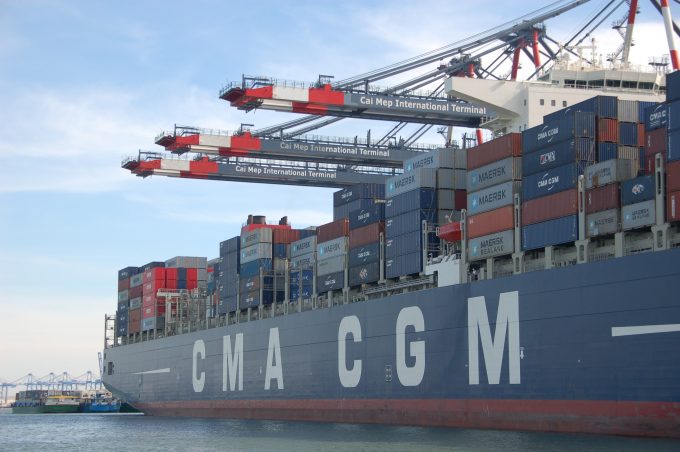Control of Wilson Sons could boost MSC dominance in Brazil
MSC’s acquisition of Brazilian operator Wilson Sons has raised eyebrows among forwarders in the region, ...
GM: RAISING THE ROOF GGM: IN FULL THROTTLE GZIM: MAERSK BOOST KNIN: READ-ACROSSMAERSK: NOT ENOUGHMAERSK: GUIDANCE UPGRADEZIM: ROLLERCOASTERCAT: HEAVY DUTYMAERSK: CATCHING UP PG: DESTOCKING PATTERNSPG: HEALTH CHECKWTC: THE FALLGXO: DEFENSIVE FWRD: RALLYING ON TAKEOVER TALKODFL: STEADY YIELDVW: NEW MODEL NEEDEDWTC: TAKING PROFIT
GM: RAISING THE ROOF GGM: IN FULL THROTTLE GZIM: MAERSK BOOST KNIN: READ-ACROSSMAERSK: NOT ENOUGHMAERSK: GUIDANCE UPGRADEZIM: ROLLERCOASTERCAT: HEAVY DUTYMAERSK: CATCHING UP PG: DESTOCKING PATTERNSPG: HEALTH CHECKWTC: THE FALLGXO: DEFENSIVE FWRD: RALLYING ON TAKEOVER TALKODFL: STEADY YIELDVW: NEW MODEL NEEDEDWTC: TAKING PROFIT

CMA CGM has decided to extend its controversial emergency bunker surcharge (EBS) to include cargo loaded on or after 1 July, despite the average price of fuel coming off its peak.
A statement from the French carrier maintained that since the announcement of the EBS on 25 May, “prices have continued to rise more sharply”.
As a consequence the $55 per teu charge would continue to apply through July and be “re-evaluated on a monthly basis”.
Since the peak of $443 per tonne of Rotterdam-sourced IFO380 heavy fuel oil (HFO) was reached on 22 May, the market price has declined and was down to $413 one month later.
But volatility remains, last week there was a fresh spike in the price of oil – a reaction to OPEC and geopolitical uncertainties, resulting in IFO380 at around $440 per tonne at the end of June.
One industry expert told The Loadstar today that, notwithstanding the market rate, CMA CGM could actually be paying more for its bunkers than a month ago depending on how it hedged its fuel procurement.
“Regardless of its hedging policy, it generally takes around eight weeks for the bunkers to hit the tanks of its ships after ordering, so there is always going to be a cost delay factor,” he said.
Led by MSC, which described its EBS as a “last resort”, ocean carriers have rolled out fuel surcharges one after the other, averaging $120 per feu, since 1 June – apart from US FMC-controlled trades, where due to the required notice period it was not applicable until 1 July.
The EBS notices angered shippers and their representative bodies around the world, with the European Shippers’ Council (ESC) being particularly vociferous, accusing the carriers of “price-signalling”.
In a letter to the European Commission, it accused the shipping lines of “unjustified” use of the word “emergency”, given that oil prices had been rising gradually for several months, during which time the carriers had entered into new contracts with customers.
It added: “Oil price fluctuations, up or down, had been frequently happening in the past years and no negative surcharge was applied when a barrel of oil went down to $40 some time ago.”
Nevertheless, the shock profit warning issued by Hapag-Lloyd on Friday, which it attributed to an “unexpected significant and continuing increase” in its operational costs, especially in regard to “fuel-related costs and charter rates”, was stark evidence that the increased cost of fuel is hitting the bottom line of carriers very hard, with Hapag-Lloyd “merely the first to put it in writing”.
Last week, The Loadstar’s in-house analyst, Alessandro Pasetti, took a close look at the negative impact that increased fuel prices could have on CMA CGM’s P&L account, speculating that a conservative estimate would add some $300-$500m to expenses.
Comment on this article
Gary Ferrulli
July 02, 2018 at 2:06 pmBoth CMA and the writer focus on the short term impact of fuel when in fact the
price of fuel has risen nearly 70% in 19 months, 50% in last 12 months. The carriers mistakenly didn’t implement a surcharge in the third quarter of 2017 which would have been justified. Now shipper want it removed because of a 1 or 2% drop in price??
Mike
July 10, 2018 at 12:04 amGary,
Since the fuel prices increased 50% since 12 months…is it fair to say that carriers increased their BAF surcharges as well?